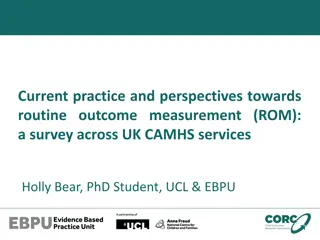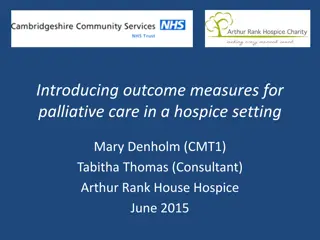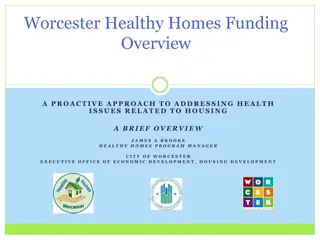Population-based Outcome Measures: Healthy Days at Home and Preventable Admissions
The content discusses population-based outcome measures focusing on Healthy Days at Home (HDAH) and Potentially Preventable Admissions (PPA). It explores the direction for Medicare quality measurement, emphasizing the importance of these measures in evaluating healthcare quality. The concept, calculation method, and risk-adjustment model for HDAH are detailed to provide a comprehensive understanding of the measurement process.
Download Presentation

Please find below an Image/Link to download the presentation.
The content on the website is provided AS IS for your information and personal use only. It may not be sold, licensed, or shared on other websites without obtaining consent from the author. Download presentation by click this link. If you encounter any issues during the download, it is possible that the publisher has removed the file from their server.
E N D
Presentation Transcript
Population-based outcome measures: Healthy days at home and potentially preventable admissions and emergency department visits Ledia Tabor and David Glass November 4, 2016
Overview The Commission s direction for Medicare quality measurement Updated analyses of population-based outcome measures Healthy days at home (HDAH) Potentially preventable admissions (PPA) Potentially preventable emergency department visits (PPV) Future research 2
New direction to simplify Medicare quality measurement Small set of population-based outcomes, low- value care, and patient experience measures Report performance for Medicare Advantage (MA) plans, accountable care organizations (ACOs), and fee-for-service (FFS) in a local market area Adjust payments to MA plans and ACOs based on quality performance Possibly apply measures to FFS clinician payment 3
Healthy days at home (HDAH): Measure concept Number of days within a year that beneficiaries are alive and out of health care institutions Consistent with quality measurement principles Comprehensive and outcomes-focused Easy for beneficiaries to understand Useful to compare performance across payment models 4
HDAH: Calculating the measure Healthy Days at Home = 365 days [Days in: (Short term acute care hospital + Inpatient rehabilitation facility + Long term care hospital + Inpatient psychiatric facility + Skilled nursing facility + Observation status + Emergency department use) + Home health visits + Mortality days] 5
HDAH: Risk-adjustment model Ensure measure reflects quality of care not patient severity Used linear regression to test a risk- adjustment model Disease burden: greatest impact Age: some impact Sex: about the same as age Market-fixed effects Medicaid status: someimpact, but no explanatory power Race/ethnicity: no significant impact 6
HDAH: Effect of Medicaid Percent of Markets in each Quartile of HDAH Highest quartile (best) Lowest quartile (worst) Second quartile Quartile of Medicaid Third quartile 32.2% Top (Most Medicaid) 21.8% 20.2% 25.7% Second 20.1 26.2 25.6 28.2 Third 21.0 28.8 29.8 20.4 Bottom (Least Medicaid) 37.0 24.7 19.2 19.2 Notes: Using 1,234 market areas. HDAH adjusted for age, sex, disease burden, market fixed effects. Data preliminary and subject to change. Source: Analysis of 20 percent of 2013 Medicare claims data. 7
HDAH: Adjusted results by population segment All <65 65+ 65+, CHF 65+, 2+CC 335.7 346.2 353.6 346.2 306.2 Mean 17.6 3.4 5.4 5.3 10.3 Standard deviation 10th percentile 332.0 350.1 339.7 329.1 293.6 348.8 353.8 346.6 336.0 306.7 Median 358.8 356.7 351.9 341.5 317.8 90th percentile Difference between 90th and 10th percentile Notes: CC (chronic condition), CHF (congestive heart failure). Adjusted HDAH rate (age, sex, disease burden, market fixed effects) for 1,234 market areas. Data preliminary and subject to change. Source: Analysis of 20 percent of 2013 Medicare claims data. 26.8 6.6 12.2 12.4 24.2 8
HDAH: ACOs compared to non-ACO FFS 360.0 354.3 353.2 349.4 348.1 347.8 350.0 346.6 Adjusted-Healthy Days at Home ACO Non-ACO 337.6 340.0 336.2 330.0 320.0 308.3 310.0 306.6 300.0 290.0 280.0 All <65 65 + 65+, 2+CC 65+, CHF Notes: CC (chronic condition), CHF (congestive heart failure). Adjusted HDAH rate (age, sex, disease burden, market fixed effects). ACOs include Medicare Shared Savings and Pioneer. Data preliminary and subject to change. Source: Analysis of 20 percent of 2013 Medicare claims data. 9
Potentially preventable admissions (PPAs) and ED visits (PPVs) Population-based measure designed to examine the ambulatory care system in a defined area Not a measure of hospital quality Comparatively higher rates in a region may point to need for improvement Not all events are avoidable; the relative rate is important 10
Potentially preventable admissions (PPAs) Hospital stays can pose risks to patients (e.g., hospital associated infections, pressure ulcers) PPAs include admissions for: Conditions that might have been prevented by coordinated care Procedures whose appropriateness has been questioned by clinical experts Exclude 30-day readmissions 11
Potentially preventable ED visits (PPVs) ED visits discourage care management and can encourage over-treatment PPVs include ED visits for: Conditions that might have been prevented by coordinated care Conditions that could have been addressed in ambulatory care settings in the community Exclude ED visits that result in admission 12
PPAs and PPVs: Adjustment methods 3M methodology makes two adjustments: Type of services and relative resource intensity Underlying health status of the population: age and burden of chronic illness Performed a linear regression and found age and disease burden account for most effects on rates - race/ethnicity and Medicaid status had very little effect 13
PPAs and PPVs: National rates PPAs: About 15 percent of all FFS Medicare hospital admissions (approximately 41 PPAs per 1,000 beneficiaries) PPVs: About 75 percent of all FFS Medicare non-admission ED visits (approximately 291 per 1,000 beneficiaries) 14
PPAs and PPVs: Market area rates PPA 1.00 PPV 1.00 Mean (population- weighted) 10th percentile (highest performing) 0.85 0.24 25th percentile 50th (median) 75th percentile 90th (lowest performing) Difference between 90th and 10th percentile 0.94 1.06 1.19 1.32 0.72 0.98 1.14 1.29 0.47 1.05 Note: A market area with a ratio less than 1 is a higher-performing area; its actual rate of PPAs/PPVs is lower than the rate that is predicted based on the age and disease severity of beneficiaries who reside in that area. 1,227 markets. Data are preliminary and subject to change. Source: Analysis of 100 percent 2013 and 2014 Medicare claims data. 15
PPAs and PPVs: Market-level ACO and FFS-only rates PPA PPV FFS only ACO FFS only ACO 0.96 0.98 1.26 1.17 Boston 1.02 0.94 0.86 0.84 Houston 0.98 0.97 1.11 1.04 Minneapolis 1.11 1.05 0.78 0.76 Orlando 0.88 0.90 1.06 1.04 Phoenix Note: ACOs (accountable care organizations), FFS (fee-for-service), ACO rate is average for all beneficiaries in ACOs in area. ACOs include Medicare Shared Savings and Pioneer. Data are preliminary and subject to change. Source: Analysis of 100 percent 2013 and 2014 Medicare claims data. 16
PPAs and PPVs: Using hospital service areas for FFS clinicians Market areas may be too large to measure FFS clinicians effect on care coordination and access Hospital service areas (HSAs) are perhaps more similar to ambulatory care environment clinicians can affect Example market area with 13 HSAs had range of HSA-level results PPA = 0.55-1.26 PPV = 1.15-1.64 17
Discussion: Future research Continue to explore effects of Medicaid status within and across market areas Understand variation in subsets of the population Calculate results for three years and compare year-to-year variation Compare ACOs within market areas over time 18

























